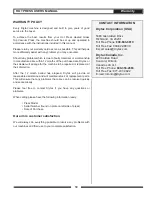
HOT PRESS USERS MANUAL
10
P
RINCIPLES
OF
O
PERATION
Your Hot Press Glass Top Vacuum Press is precision
engineered to deliver the optimum heat and pressure for
a variety of mounting and overlaminating applications. A
conductive coating is applied to the upper surface of the
lower of two sheets of tempered glass that form the lid
of the press. When an electrical current is applied to the
coating, the glass heats up in a very even and consistent
manner.
When the lid is closed onto the gasket around the
outside of the bottom frame, it forms an airtight chamber
from which air is drawn out by the vacuum pump. The
vacuum causes the fl exible diaphragm in the base, and
any materials placed on it, to be pressed against the
glass, thus applying the heat and pressure needed to
bond materials together.
Key Processing Factors:
There are three key processing settings that apply to virtually all
mounting and laminating jobs.
• Temperature
• Time (Dwell)
• Pressure
Temperature:
The temperature setting is primarily dictated by the
requirements of the heat-activated adhesives used in the dry mounting
tissue and the overlaminating fi lm recommended for your job. It is
important that the press be operated at the correct temperature to
activate the adhesive and bond the materials. See page 8 for more on
temperature controls.
Time (Dwell):
This factor works in conjunction with temperature to create
a permanent bond between materials. Assuming that the temperature
setting of the press is suffi cient to activate the adhesive, it is almost
always preferable to increase dwell rather than temperature. Dwell time
is set using the Timer (page 9) and dictates the vacuum cycle (see
Pressure, below).
Pressure:
Pressure is established in the press by the vacuum pump,
which is controlled by the Timer (see page 9). The vacuum presses
the materials together for the amount of time chosen by the operator
using the timer controls. Pressure should usually be set at over 25” of
mercury. It should be reduced for softer mounting materials such as
foam board using the vacuum adjustment valve.
Other Factors
Following the recommended temperature and time settings on your
Glass Top Vacuum Press will almost always produce excellent results.
However, other factors can affect the settings on the machine.
Materials
: Manufacturer’s dwell and termperature settings are based on
paper graphics. However, heavier materials such as canvas absorb more
heat and may require a higher temperature setting or longer dwell time
setting. This is also true for denser or thicker mounting substrates.
Workpiece size:
The same principle applies to the overall size of the
job. Larger jobs absorb more heat and may require longer dwell times.
Controls
NOTE:
Whenever possible, test actual
materials together prior to processing a
challenging or unusual job.
Illustration 10A:
Key processing factors





































